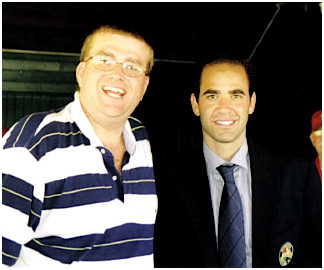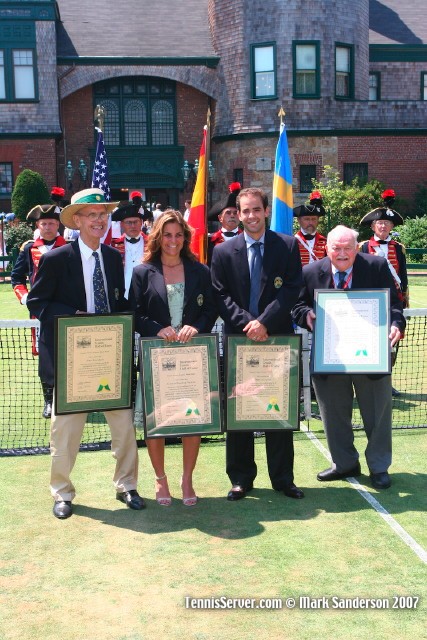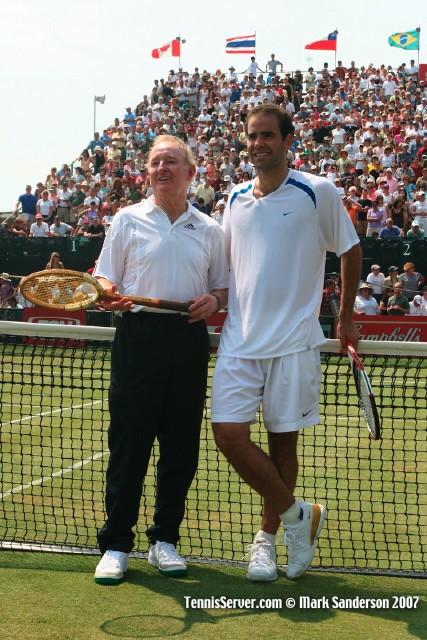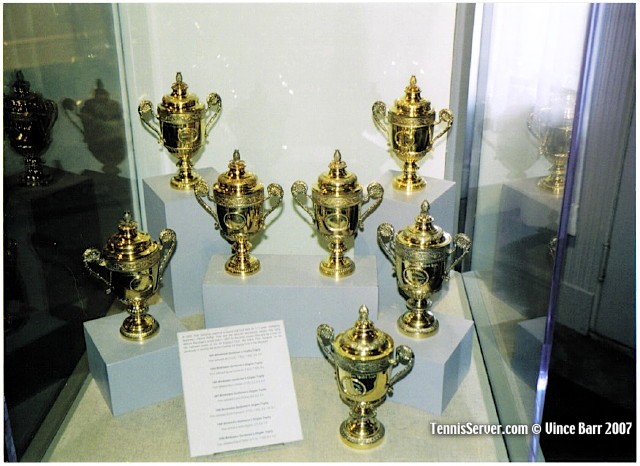November 2007 Article Wild Cards Archives:
Tennis Server
|

 |
by Vince Barr
The 2007 International Tennis Hall of Fame induction ceremony took place in Newport, Rhode Island last July 14th as Pete Sampras, Arantxa Sanchez-Vicario and Sven Davidson were inducted as former touring professionals. Additionally, photographer Russ Adams was also inducted, becoming the first (and only) photojournalist to be so honored. Although you might not recognize Adams by name, you've probably seen his work since over 250 of his tennis pictures have made the covers of various magazines throughout his over 50-year career. His tennis career started innocuously as he had no idea how to cover the sport, keep score or even understand exactly what he was supposed to be doing. Fortunately for him, Hazel Wightman, director of the 1955 Massachusetts Women's Championship at the Longwood Cricket Club in Boston, showed him how to shoot the game of tennis.
Adams recalled that "I was lucky that first day at Longwood. It could have been a mess... She took me in hand, showed me what to look for, when to shoot (and) introduced me to (the) players." Adams must have taken her tutelage to heart as he went on to a very illustrious career in photojournalism, capturing some of the best moments in both men's and women's professional tennis over the last five decades. He has been credited with developing a professional code of ethics that governs the behavior of professional photojournalists at tennis matches. It was also his idea to place photographers on the court in order to capture fantastic action shots of their subjects. At the induction ceremony, Bud Collins, the erstwhile NBC Television tennis analyst and columnist for the Boston Globe dryly remarked that "...unlike the other inductees we honor today, Russ still has his job." Despite his age, he has no plans to retire anytime soon.
Outside of tennis, Russ served honorably in the U. S. Air Force during World War II in the world-famous Strategic Air Command. One of his main responsibilities was taking high altitude reconnaissance photos of enemy positions. Later, during the "Cold War" this meant flying numerous missions over Moscow from 70,000 feet, snapping pictures of military installations in the former Soviet Union. After his honorary discharge from the military, he went back to work for a variety of newspapers and was assigned to cover Major League Baseball, ice hockey and even the high fashion shows in Paris, Milan and Rome. From there, he drew the assignment to cover the women's tennis championships in Longwood, Massachusetts and the rest is history.
Sven Davidson is probably not a name that stirs any particular memories in most people who follow men's professional tennis. This is largely due to the fact that his many accomplishments occurred in the pre-Open era. Yet, he was the first Swedish player to win a Grand Slam title at the French Open in 1957. While playing as an amateur, he was ranked in the Top 10 for five consecutive years (1953-58) with a peak ranking of # 3 in 1957. He won the doubles championship at Wimbledon in 1958 and played on a consistent basis for Sweden's Davis Cup team from 1950-61, posting a career record of 62-23. Davidson had many contributions to the game of professional tennis that largely have gone unrecognized. For example, he created the first professional tennis tournament in northern Europe (what is now the Stockholm Open) in 1969. Perhaps more importantly, he "initiated the first general meeting of the International Tennis Federation (Paris, 1968) where the advent of 'open' tennis was discussed and where 47 countries agreed in principle to the idea." Davidson also provided tennis coverage for Swedish television for a number of years. He provided the most poignant moment of the induction ceremony by revealing that he had been recently diagnosed with Alzheimer's disease and was in the early stages of his illness.
In the recent player category, Spain's Arantxa Sanchez-Vicario became the first Spanish woman (and only the 2nd Spanish player) to be inducted into the International Tennis Hall of Fame. She was also the first Spaniard to win the U.S. Open, doing so in 1994 and added three Opens to her trophy case (1989, 1994 & 1998) in the 18 years she played on the WTA Tour. She attained the Number 1-ranking and displayed an uncanny ability to win doubles titles (67) as well as singles championships (29) which is something many professional players (either men's or women's) don't even attempt. She was a regular contributor for her country in the Fed Cup competition, playing for an astounding 16 of her 18 years on Tour. Certainly, a great portion of Spain's dominance in winning Fed Cup titles (1991, 1993, 1994, 1995 & 1998) can be directly attributed to her participation on their team.
Perhaps the most celebrated player to enter the hall of fame in the last 25 years is America's own Pete Sampras. Rod Laver, to whom Pete is often compared, entered the hall in 1981. Both players exhibited an uncanny ability to win big matches, capture major titles and win the majority of the matches they have played. In Pete's case, his overall career win - loss record of 762-222 is simply amazing; that calculates to a 77.4% winning percentage which means that, on average, pick any four matches at random and Pete generally would win at least three of them. Of course, if those random matches included clay court events, chances are his success rate would be significantly lower. But nearly all the greats have at least one surface that they simply can't seem to win on a consistent basis. Borg could not prevail on the hard courts of the U.S. Open. Ivan Lendl struggled on the grass at the All England Lawn & Tennis Club.
Shortly after his official retirement, I wrote for Tennis Server a lengthy column on Sampras's career and contributions to the game. I've made no secret of the fact that I admired the way he played the game and conducted himself off the court as well. I listed many of his accomplishments in my previous article but wanted to add somewhat of a postscript on what he has meant to the game of men's professional tennis. Roger Federer will soon break Pete's record of 14 slam wins which is the most slam victories to date by a male tennis professional. Federer has already broken other records Pete has held, such as the number of weeks spent at the No. 1 ranking throughout their career.
In light of this, many people have dismissed Pete's accomplishments, which is blatantly unfair. Everyone has their favorite players and I strongly believe that you cannot compare players from different eras due to changes in the game, competitive conditions and so forth. At the induction ceremony, Rod Laver was asked who the best player of all time is. Many think that Pete was the best, those who disagree often cite Laver's accomplishments of winning two Grand Slams in the same calendar year as proof that he is the best player ever. Usually, when the media identifies the "best ever" they are talking about who has won the most major titles. Laver had a different perspective that Pete was the greatest player of the 1990s and few would disagree with that assessment. His point, similar to my own, is that 10 years seems to be about the time period where generations of tennis players "change over."
In my opinion, Laver is right. Before Federer came along, the argument was Pete vs. "The Rocket" and even that comparison was unfair. Laver has admitted that the depth in men's tennis was not nearly as great when he played as it was in the 1990s when Pete was dominant. Then there is the issue of Laver losing many of his most productive years since he was not allowed to compete for the majors in the pre-Open era because he was a professional and those trophies went to amateurs only. In Pete's case (as compared to Laver), Rod played three of his four slams on a grass surface. How many majors could he have won once he figured out how to play on that surface? The answer is that we will never know and anyone claiming information to the contrary is simply giving their unbridled opinion.
Perhaps this point (that you can't really compare players of different eras) is best illustrated with an example. Pete has a 3-0 career record over John McEnroe with two of the matches being played in 1990 and the other in 1991. There is a 12-year age difference between both players which is difficult for anyone to overcome. While it is tempting to say that Pete was a better player than McEnroe, you can't really make that assessment based on head-to-head match ups because of their age difference. In the 1980s, McEnroe and Jimmy Connors vied for dominance in the sport. It was (and remains) impossible to see what would have happened had they both been able to play each other during their peak years. The same holds true with Sampras and Federer, who only played once in their careers, in 2001 at Wimbledon. One match, which Pete lost, does not make for a good comparison between the players of different generations. Federer is just over 10 years younger than Pete, almost to the day.
In 2006, I asked Patrick McEnroe what his opinion was as to the outcome of a hypothetical match between Pete playing his best (e.g., 1997 at Wimbledon) and Federer playing his best (in recent years) at Wimbledon. The question spiked his curiosity and he thought long and hard about it. Both players have established lasting legacies there. After thinking about it, he threw up his hands in the air and said it would be a toss up and that he would take Sampras "10-8 in the fifth; although he would pick Federer on any other surface, including hard court and Rebound Ace." I disagreed with his hard court opinion but agreed with him on Rebound Ace since the high bounce would have mitigated one of Pete's greatest shots: the running forehand. Pete did manage to win two Australian Opens but it was probably one of his least successful major events on a hard court (obviously; he won 5 U.S. Opens vs. only 2 in Australia).
Please use this link to the Tennis Server Pro Tennis Showcase for additional photography from the 2007 Tennis Hall Of Fame Induction Ceremony. If you wish to provide a comment to the author of this Wild Cards column, please use this form. Tennis Server will forward the comment to the author.
1998 - 2003 | 2004 - Present
This column is copyrighted by the author, all rights reserved.
|



October 2022 Tennis Anyone: Patterns in Doubles by John Mills. September 2022 Tennis Anyone: Short Court by John Mills. |
 You will join 13,000 other subscribers in receiving news of updates to the Tennis Server along with monthly tennis tips from tennis pro Tom Veneziano.
You will join 13,000 other subscribers in receiving news of updates to the Tennis Server along with monthly tennis tips from tennis pro Tom Veneziano. 


